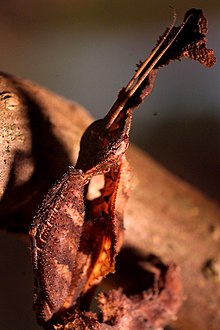Phyllocrania paradoxa, common name ghost mantis, is a small species of mantis from Africa remarkable for its leaf-like body. It is one of the three species in the genus Phyllocrania. It is known for its distinct and exclusive camouflaged appearance of a dry weathered leaf.[1][2][3][4]
| Phyllocrania paradoxa | |
|---|---|

| |
| Male ghost mantis in one of the older nymph stages, probably sub-adult | |
| Scientific classification | |
| Domain: | Eukaryota |
| Kingdom: | Animalia |
| Phylum: | Arthropoda |
| Class: | Insecta |
| Order: | Mantodea |
| Family: | Hymenopodidae |
| Genus: | Phyllocrania |
| Species: | P. paradoxa
|
| Binomial name | |
| Phyllocrania paradoxa (Burmeister, 1838)
| |
Description edit
Compared to many other praying mantises, the ghost mantis is a "miniature species"[3] growing to only about 45 to 50 millimetres (1.8 to 2.0 in) long.[2]
It comes in various brownish shades from very dark brown (almost black) to greenish gray. An individual's colors change between molts and are also dependent on light and humidity levels.[2][3]
Phyllocrania paradoxa is camouflaged so as to appear as dead, dried-up leaf material.[5] It has an elongated head, a flattened, extended prothorax and leaf-like protrusions from its limbs.[5] The mantis also has a forewing that looks like a desiccated leaf,[1] and the "creases" in the wings are actually shadings of pigment.[4] In the wild, the ghost praying mantis effectively blends in against dead leaves. Predators such as birds tend to overlook insects that resemble their background, and by staying still the ghost praying mantis can go unnoticed.[6]
If threatened, big nymphs and adult females adopt thanatosis, i.e. they play dead, whereas adult males run or fly away.[7]
P. paradoxa oothecae can hatch out up to three dozen young.[8] 1st and 2nd instar nymphs of this species are dark colored and use ant mimicry as a defense.[7]
Sexual Dimorphism edit
As with most or all species of mantis, Phyllocrania paradoxa is sexually dimorphic, with females being larger than males. Females have six abdominal segments. Males are shorter, narrower, and have eight-segmented abdomens.[3] At the 5th instar and above males are thinner than females and have smaller appendages (lateral of the abdomen). At the 6th instar and above their crowns are different. When adult, males have longer and thicker antennae than females and transparent wings, which are longer than the abdomen. They are good flyers and are significantly thinner than the females. At the 5th instar and above females are more compact than males and have bigger appendages. At the 6th instar and above the crown of females are as wide as their head and more line and smoother than the male`s crown. When adult, females are significantly more compact than males, with shorter antennae and wings that do not cover the abdomen.
Range edit
Phyllocrania paradoxa have a wide range across the African continent and its islands and can be found in Angola, Cameroon, Cape Province, Congo basin, Ethiopia, Ghana, Guinea, Ivory Coast, Kenya, Malawi, Madagascar, Mozambique, Namibia, Somalia, South Africa, Sudan, Tanzania, Togo, Transvaal, Uganda and Zimbabwe.[2][9][10] It is also found in South Europe.
Habitat edit
Ghost mantis inhabit dry areas, bushes, shrubbes, trees in the open.[11]
Gallery edit
See also edit
Bibliography edit
- For a technical discussion of an aspect of this species' anatomy refer to The cervical sclerites of Mantodea discussed in the context of dictyopteran phylogeny by Frank Wieland, Entomologische Abhandlungen 63, Museum für Tierkunde Dresden, 2006
References edit
- ^ a b "Ghost Mantis - Phyllocrania paradoxa". Archived from the original on 2008-06-08. Retrieved 2008-07-20. pawsforthoughtpetcentres.co.uk
- ^ a b c d [1] Archived 2008-06-08 at the Wayback Machine PhasmidsinCyberspace.com 2005
- ^ a b c d [2] Archived 2008-11-21 at the Wayback Machine PrayingMantid.co.uk
- ^ a b [3] Archived 2008-08-07 at the Wayback Machine 2006 Bugman Educational Entoprises
- ^ a b [4] exotic-pets.co.uk
- ^ "Praying mantis good for the garden". The Mercury News. 2017-02-08. Retrieved 2017-11-22.
- ^ a b [5] Mantis Study Group Newsletter
- ^ [6] Archived 2016-03-04 at the Wayback Machine USA Mantis
- ^ [7] Phyllocrania paradoxa(in Swedish
- ^ [8] The Hymenopodid Praying Mantises (Mantodea: Hymenopodidae) of South Africa Compiled by Alfred P. Kaltenbach, Naturhistorisches Museum in Wien, Burgring 7, A-1014 Wien, Austria
- ^ "MantisOnline.de - Species". Archived from the original on 2017-05-10. Retrieved 2022-06-30.
External links edit
- [9] Bolton Museum and Archive Service
- [10] 2007 InsectaCulture Videos of Phyllocrania paradoxa
- Ghost mantis care sheet
- Deadlymantis.com This site have some amazing pictures of praying mantis and information on multiple species. Also, there are links to supplies for rearing and exotic live specimens.
External links edit
- Media related to Phyllocrania paradoxa at Wikimedia Commons